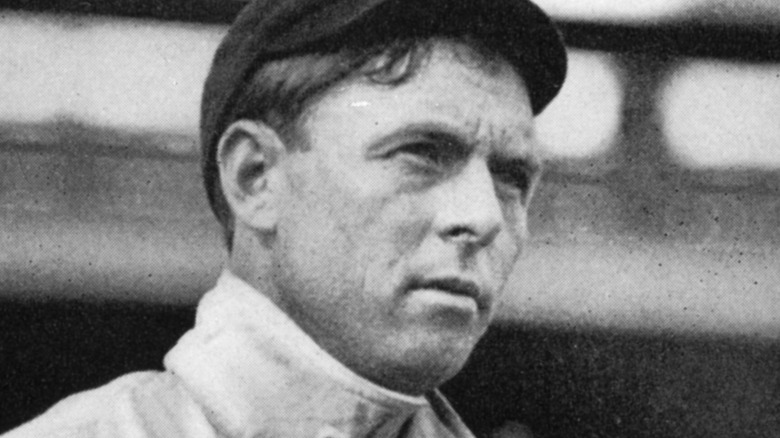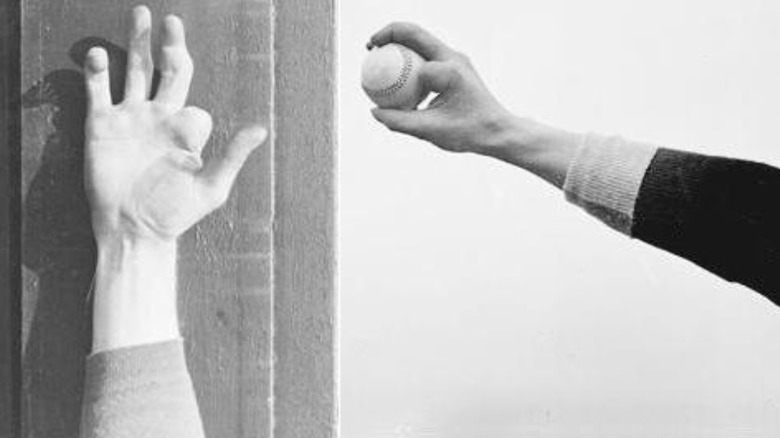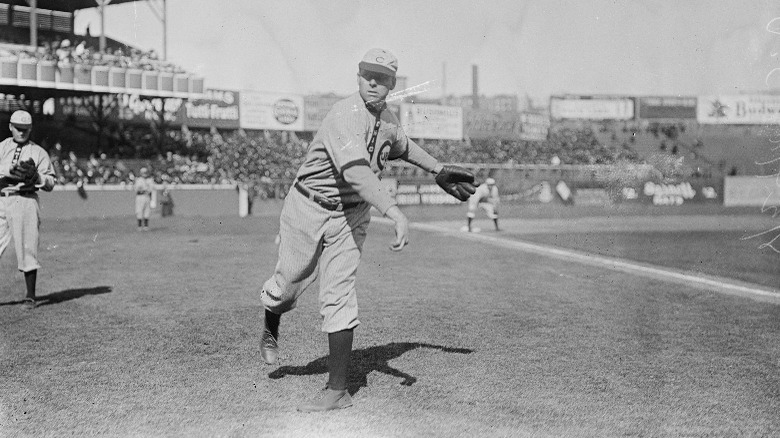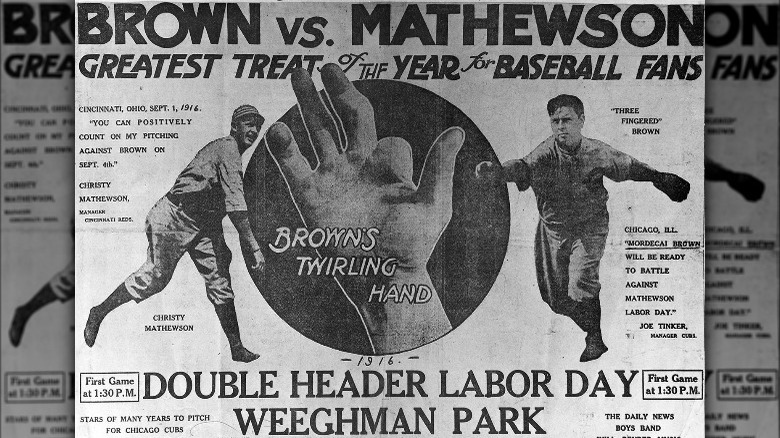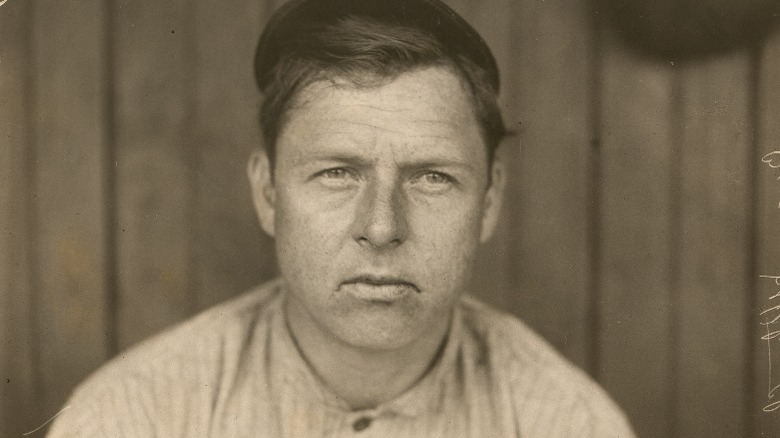How A Gruesome Farm Accident Helped Mordecai Brown Become A Hall Of Fame Pitcher
One doesn't need to be particularly astute to wager a pretty good guess as to why Mordecai Brown was better known as Mordecai "Three Finger" Brown. While Brown was born with all five digits on his right hand intact, he overcame a severe injury as a child that would've made the prospect of a career as a major league baseball player seem unlikely. Brown went on to become a Hall of Famer, and one of the preeminent ballplayers of the early 20th century, yet like many players from that era, he came from humble beginnings.
Brown's full name was Mordecai Peter Centennial Brown — the name Centennial being a nod to his birth year, 1876 — and he grew up in Indiana, per Society for American Baseball Research (SABR). Brown was one of eight children, some of whom had some baseball chops as well. His brother John went on to become a semi-pro player, and some have said he was every bit as good as Mordecai, but just didn't apply himself properly.
Mordecai becomes Three Finger
When Brown was just 7 years old, he suffered the injury that would lead to his famous nickname and, depending on who you ask, some aspects of his pitching ability as well. The young Mordecai Brown let curiosity get the best of him, per SABR, and stuck his hand in a piece of farm equipment. According to Bleacher Report, that piece of equipment was a corn shredder, and Brown quickly learned that despite the name, it could shred much more than corn.
Brown was left with a stump where the index finger used to reside on his right hand — his throwing hand — but that wasn't the end of the injuries. Not long after the incident with the corn shredder, Brown was chasing a rabbit when he fell and was left with a crooked middle finger and a paralyzed pinky on the same hand, These injuries led to his famous nickname, "Three Finger." Brown's other, less famous nickname was "Miner," something he picked up because he worked as — you guessed it — a miner when he was in his teens. (They weren't particularly creative back in the day when it came to nicknames).
Mordecai Brown the pitcher
Despite his injuries, Brown taught himself how to pitch by hucking rocks at the side of a barn (via Bleacher Report). He soon discovered the unusual grip he had to use as a byproduct of his injuries gave him the ability to put a lot of spin on the ball.
Where Brown grew up, it was common for towns to have their own baseball teams as a way for workers — especially those who toiled away in the mines like himself — to blow off some steam. Brown was playing for one of these teams as a third baseman when he got the nod to fill in for the team's regular pitcher. The extra spin he managed to put on the ball — which was a major problem for throwing across the diamond as an infielder, according to SABR — was a major advantage for Brown. Hitters were simply unable to track down his elusive pitches.
According to the Baseball Hall of Fame, Ty Cobb, who was one of the best hitters in league history, once summed up how hard it was to hit off of Brown: "It was a great ball, that downward curve of his," Cobb said. "I can't talk about all of baseball, but I can say this: It was the most deceiving, the most devastating pitch I ever faced."
Brown makes his major league debut
Mordecai "Three Finger" Brown took his ability to put a little extra English on the ball to the major leagues when he signed with the St. Louis Cardinals in 1903. That season he had his first run-in with another one of the era's greatest pitchers, Christy Mathewson. Brown and Matheson faced each other for the first time on July 9, 1903, with Mathewson's New York Giants topping the Cardinals 4-2. Brown pitched all nine innings, allowing 14 hits but also notching six strikeouts. Mathewson didn't strike anyone out that game (via Baseball Reference).
Brown's tenure with the Cardinals was short and in 1904 he was traded to the team with whom he spent the bulk of his time in the big leagues, the Chicago Cubs. According to SABR, the Cubs would've been very familiar with what Brown was capable of, as his first win in his rookie season came against them. With the Cubs, Brown quickly improved his stats and has club records that stand to this day, like most shutouts (48) and the lowest career ERA (just 1.80).
Brown's best seasons were with the Cubs. He helped them reach the World Series four times, including back-to-back wins in 1907 and 1908, per Baseball Reference.
The tail-end of a Hall of Fame career
In 1914, Brown left the Cubs to join an upstart league known as the Federal League. The league debuted the same year and Brown spent two years — the duration of its existence — split among three clubs. He played for the St. Louis Terriers and Brooklyn Tip-Tops in 1914, then spent the 1915 season back in Chicago, only this time he was with the Chicago Whales, per Baseball Reference.
Dispute the presence of other former major leaguers, the Federal League folded before the 1916 season could get underway. With a little bit of gas left in the tank, Brown returned to the Chicago Cubs for one last hurrah. At just shy of 40 years old, Brown only appeared in 12 games, including one last bout with Mathewson, who won their finale, but Brown remained ahead 12-11 through all of their meetings, per SABR.
Brown left the major leagues after that season, but did pitch a few more seasons for various minor league clubs before settling in his home state of Indiana, where he ran a gas station and occasionally appeared in old-timers' games. Mordecai "Three Finger" Brown died in 1948 and was elected to the Baseball Hall of Fame the following year.
